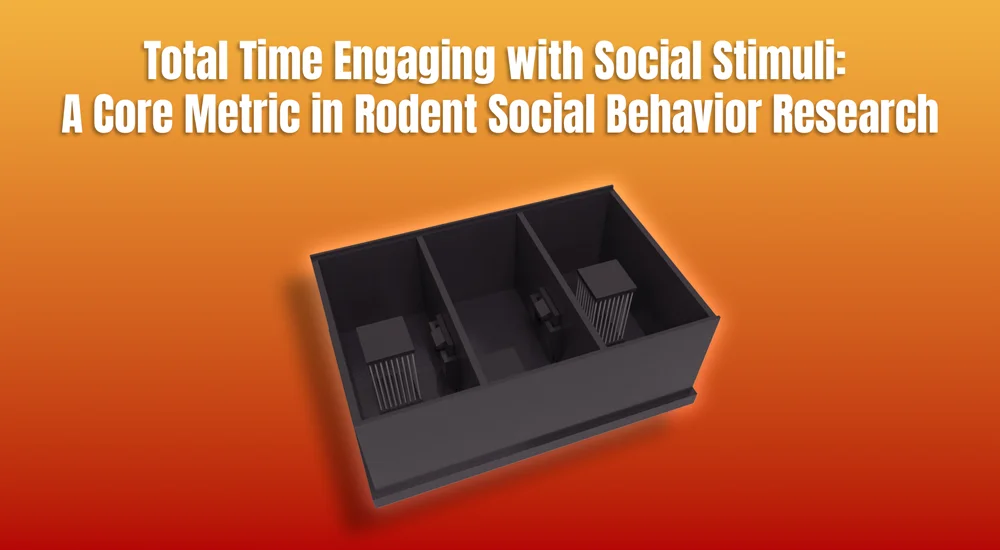

Social interaction is one of the most fundamental behaviors across animal species, from humans to rodents. It reflects the complex interplay between motivation, cognition, sensory processing, and affective states. In the context of behavioral neuroscience, dissecting social behavior offers a powerful means to study the neural substrates of psychiatric and neurodevelopmental disorders, including autism spectrum disorder (ASD), schizophrenia, depression, and Alzheimer’s disease.
But how does one measure “social behavior” in a reliable, quantifiable way? In preclinical research, where precision is paramount, this question is central to evaluating genetic models, pharmacological interventions, and behavioral therapies. That’s where metrics like Total Time Engaging with Social Stimuli become indispensable.
This deceptively simple parameter—how long an animal interacts with a social target—serves as a window into social motivation, recognition, and preference. It provides a sensitive and dynamic measure of how animals respond to conspecifics in structured environments. Used widely in translational research, this metric can reveal the first signs of social dysfunction, signal recovery post-treatment, or validate the behavioral relevance of a novel compound.
One of the most effective platforms for studying this behavior is the Sociability Chamber Maze. This three-chambered apparatus creates a controlled environment where rodents are presented with a choice: engage with a social peer or explore a non-social stimulus. The resulting data, particularly Total Time Engaging with Social Stimuli, is more than a number—it is a direct behavioral output of underlying neurological processes.
This article aims to unpack the significance of this metric in full: its theoretical underpinnings, methodological best practices, interpretative frameworks, and practical applications in experimental research. By the end, you will see why Total Time Engaging with Social Stimuli is a cornerstone of modern behavioral science, and how it continues to advance our understanding of the social brain.
Total Time Engaging with Social Stimuli is a behavioral metric that captures the cumulative amount of time an animal spends actively interacting with a social stimulus within a controlled testing environment—most commonly the Sociability Chamber Maze. This interaction is not random; it reflects the animal’s intrinsic or condition-induced social motivation, interest, and cognitive ability to recognize and process social cues.
But to understand the weight this metric carries, we need to appreciate the nature of social behavior in rodents, and how it manifests in measurable terms.
In experimental settings, “engagement” is strictly defined based on observable and reproducible behaviors. Engagement typically includes:
This deliberate interaction distinguishes social behavior from random locomotion, environmental exploration, or stress-induced hyperactivity.
Social engagement time is more than a behavior—it’s a proxy for brain function. In rodent models, healthy animals naturally display a preference for conspecifics over inanimate objects, suggesting that social interaction is inherently rewarding. When this behavior is altered, it often mirrors deficits seen in human social functioning.
The importance of this metric lies in its ability to reflect key neurobehavioral functions:
This metric is grounded in the evolutionary conservation of social behavior. Rodents, especially mice and rats, are naturally social creatures. Their social networks are integral to survival, mating, hierarchy formation, and territoriality. Disruptions in these innate patterns due to genetic mutation, environmental insult, neurochemical imbalance, or pharmacological manipulation are readily observable as changes in social engagement duration.
In fact, several neurological and psychiatric disorders are typified by changes in social behavior well before cognitive symptoms become obvious. Thus, this metric serves as an early behavioral biomarker for:
In modern behavioral labs, social engagement time can be quantified through:
Note: Whether using manual or automated methods, it’s critical to define the interaction zone, calibrate equipment, and validate scoring protocols to ensure consistent and replicable results.
Just being in the same chamber as a social stimulus is not necessarily engagement. For example:
This reinforces the importance of defining specific behavioral criteria to prevent over- or under-estimation of actual social engagement.
In summary, Total Time Engaging with Social Stimuli is not just a convenient number—it is a behavioral fingerprint of how an animal processes social information, driven by a complex web of neural systems and internal states. It remains one of the most reliable, interpretable, and meaningful metrics in social behavior research, especially when applied through robust, reproducible methods in the Sociability Chamber Maze.
The Sociability Chamber Maze is a well-established apparatus for assessing sociability in rodents. Its design consists of three interconnected chambers:
Rodents are placed in the center and allowed to freely explore the maze. Their spontaneous preference is recorded, with Total Time Engaging with Social Stimuli serving as a primary endpoint for sociability.
The maze’s symmetry ensures unbiased spatial exploration, while the clear partition between chambers permits simultaneous visual and olfactory access to stimuli, mimicking naturalistic social scenarios in a controlled environment.
Social engagement is one of the most deeply ingrained and complex behaviors observed in mammals. In rodents, the drive to interact with conspecifics is regulated by an integrated network of brain structures, neuromodulators, and genetic pathways. The behavioral manifestation of these systems—measured in part by Total Time Engaging with Social Stimuli—offers researchers a direct avenue to assess the functional integrity of the “social brain.”
In studies utilizing the Sociability Chamber Maze, this metric serves as a behavioral endpoint that reflects real-time neuronal activity, affective states, and motivational drives. Understanding the neurobiological substrates of social behavior enhances the interpretability of engagement time and reinforces its value in translational research.
Rodent sociability is coordinated by a distributed network of brain regions responsible for decision-making, sensory processing, reward valuation, memory encoding, and emotional evaluation.
The initiation and maintenance of social interactions are shaped by a finely tuned neurochemical milieu. Several key neurotransmitters and neuropeptides are known to facilitate or inhibit social behavior.
Numerous genes have been identified as key regulators of sociability, particularly through their influence on synaptic connectivity and plasticity. Genetic mutations that alter synaptic function frequently manifest as reduced social engagement.
Beyond genetic determinants, epigenetic modifications shaped by early-life stress, maternal behavior, and environmental enrichment can alter gene expression and neurochemical signaling. These changes have long-term effects on social behavior and can significantly modulate engagement duration in adult animals.
Rodent models with ASD-like phenotypes, such as Shank3, Nlgn3, or Fmr1 knockouts, consistently show reduced time engaging with conspecifics. For instance, Peça et al. (2011) demonstrated that Shank3B−/− mice spent significantly less time interacting with a stranger mouse, validating the model’s construct and face validity for ASD.
Use Case: Comparing engagement time across wild-type and mutant groups helps identify social deficits early and track progression or treatment outcomes.
Pharmaceutical agents aimed at improving sociability—such as oxytocin analogs, mGluR5 antagonists, or SSRIs—are often screened using this metric. A dose-dependent increase in engagement time post-treatment may indicate therapeutic efficacy.
Insight: Time-based changes can also reveal optimal dosing windows and behavioral tolerability.
In models of Alzheimer’s disease, rodents exhibit social withdrawal before cognitive decline becomes apparent. Measuring reductions in engagement time allows for early detection of behavioral changes tied to preclinical neuropathology.
Reference: Latif-Hernandez et al. (2017) noted reduced sociability in APP/PS1 mice correlating with hippocampal atrophy.
The value of Total Time Engaging with Social Stimuli increases when paired with thoughtful interpretation. Here’s what different outcomes can imply:
| Observation | Interpretation |
|---|---|
| High social time | Strong social motivation; possibly pro-social effect |
| Low social time | Social aversion, anxiety, or cognitive impairment |
| Equal time in both zones | No preference; potential sign of indifference |
| Avoidance behavior | Stress, social fear, or depressive phenotype |
To increase statistical power, researchers often calculate “Social Preference Index”:

This index normalizes variability and provides a comparative sociability score.
Despite its strengths, this metric is sensitive to confounding factors:
Proper controls, randomization, and counterbalancing are essential for meaningful results. Researchers should also complement this measure with others like latency to approach, number of visits, or ultrasonic vocalizations (USVs).
The integration of behavioral metrics with molecular and neural readouts (e.g., optogenetics, calcium imaging, transcriptomics) is a growing frontier. For instance, correlating social engagement time with real-time dopamine release in the nucleus accumbens or mPFC can yield mechanistic insights into social reward processing.
This approach not only refines phenotyping but also bridges the gap between behavior and biology—making Total Time Engaging with Social Stimuli a gateway metric to translational discovery.
Total Time Engaging with Social Stimuli is more than a quantitative measure—it’s a window into the emotional, cognitive, and neurochemical states of the animal. When used judiciously within the Sociability Chamber Maze, it enables researchers to decode complex behaviors, test interventions, and explore the foundations of social cognition.
In an era of translational neuroscience and precision behavioral research, this metric stands at the intersection of rigor and relevance—enabling breakthroughs that bring us closer to understanding the social brain.
Written by researchers, for researchers — powered by Conduct Science.

Dr Louise Corscadden acts as Conduct Science’s Director of Science and Development and Academic Technology Transfer. Her background is in genetics, microbiology, neuroscience, and climate chemistry.
